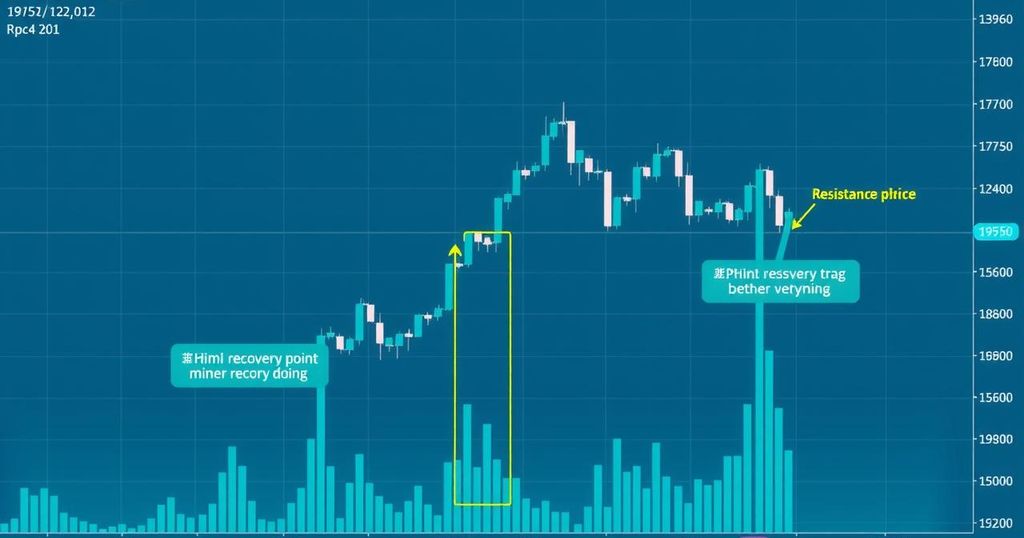Ethereum’s Price Dynamics: Resistance at $2,330 and Market Outlook
Ethereum is currently consolidating around $1,600, facing resistance at $2,330. The asset has over 106 million addresses holding ETH at a loss, complicating potential price gains. Recent declines in transaction fees and whale activity have also hindered momentum, but some retail trader optimism is emerging with outflows indicating potential long-term positioning. Overall, Ethereum needs to break key resistance levels for a significant price surge.
Ethereum is currently consolidating around the $1,600 mark but is encountering significant resistance near $2,330, which is critical for its future price movements. To initiate a substantial rally, Ethereum must first surpass this resistance level. This article explores Ethereum’s market dynamics, potential price movement, and key factors to monitor in the near future.
The price action of Ethereum has drawn attention as it nears a substantial supply zone between $2,295 and $2,350, which contains over 6.28 million ETH across roughly 2.6 million addresses. This supply zone represents a significant resistance level. For Ethereum to transition into a bullish trend, it must overcome selling pressures from holders aiming to break even. A successful breakthrough could convert this resistance into support, propelling prices upwards.
However, the immediate outlook appears challenging, with over 106 million addresses holding ETH at a loss. This predicament may hinder price gains, as many holders could attempt to exit at break-even levels. Crossing $2,330 may signal renewed optimism, particularly if additional buying pressure from sidelined investors accompanies it.
Despite Ethereum’s recent price movements, its on-chain data tells a more complex story. Transaction fees on the network dropped by over 56% in the past week and nearly 88% over the last three months, indicating reduced network usage and demand for Ethereum, which stifles upward momentum.
Whale activity has diminished as well; net flows from large holders fell by nearly 50% in the last week and a substantial 447% over the past month. This decline in whale activity is concerning, as these larger entities often influence price movements. Without renewed institutional support and increased network activity, any attempts at price rallies could falter.
Despite mixed signals, Ethereum has demonstrated some resilience recently, gaining 3.62% in the last 24 hours to approximately $1,647.83. This recovery from a low of $1,385 suggests a potential setup for a breakout, as it approaches the resistance zone of $1,650–$1,703. A break above this resistance could signify the end of the prevailing bearish trend, with prices potentially targeting $2,330.
Nevertheless, Ethereum is still confined within a descending parallel channel that has historically restricted price growth. The horizontal resistance at $1,703 aligns with the channel’s upper boundary, indicating that further gains hinge on surpassing this hurdle.
While market sentiment remains mixed, there are optimistic signs from retail traders. Ethereum’s exchange net flows indicate weekly outflows of 29,948 ETH, which reflects a 1.96% decrease in exchange balances. This could imply a cautious optimism among retail investors, preparing for a long-term breakout. Conversely, institutional interest remains low, and reduced network engagement continues to impede Ethereum’s breakout potential.
In summary, although Ethereum’s price remains stable, breaking the $2,330 resistance is uncertain. The recent price recovery and exchange outflows point to mild optimism among retail traders, but insufficient whale accumulation and reduced network activity pose risks to any potential rallies. Ethereum remains within a descending channel, and a decisive break above $1,703, alongside increased on-chain demand, is essential for overcoming the $2,330 barrier in the short term. The next phase of Ethereum’s price trajectory will depend on stronger institutional interest and revived network activity.




Post Comment